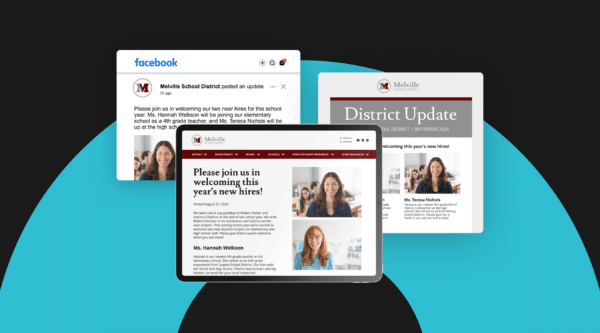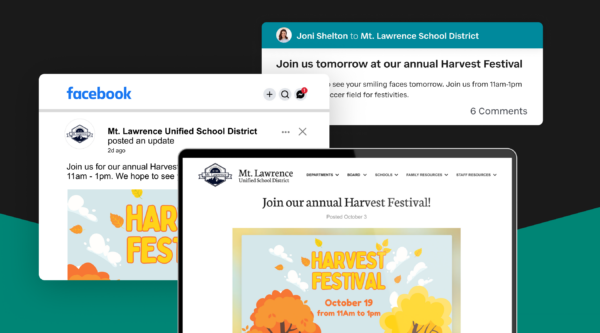

Does your school’s communication plan feel like a one-way street? Are you constantly sending information to families but have no way of gathering their thoughts, opinions, or feedback on key school issues? If so, you may be missing a crucial opportunity to improve engagement.
Schools today need to take advantage of the technology that allows them not only to share information but also to collect valuable input from families. Surveys are a powerful tool that can help you make your school website and digital communication channels more effective in connecting with your audience.
Planning is the First Step
Planning is the first step in building a new website, and a family survey is a great place to start. They’re unquestionably the most important audience segment of your website, so understanding their concerns up front in your planning process can be instrumental in making your website more effective.
With all the studies and mountains of evidence that drive home the mantra of family engagement equals successful students (i.e., successful schools), it’s time schools seize the power of technology to better understand one of their most important stakeholders.
A simple survey program using email, an online survey service, or even your school website and social media can improve engagement, community support, achievement and much more—while saving money in the process.
Email—a preferred method of school-to-home communications—is your school or district’s best opportunity to get a survey out in front of your families.
Your school’s most effective survey program is easily within reach using an email strategy following some simple steps:
1. Tell families what’s in it for them.
Be very clear about the importance of the survey and the significance of participating. That is, you not only want to better communicate with families, but ultimately improve the entire education experience for everyone.
The email should be from an actual person, not the school. You pick: superintendent, principal, communications director, whomever. Studies show people are far more likely to respond when an email is from an individual rather than an institution.
We also recommend creating an incentive for participation. Beyond an improved and ongoing communications channel with two-way responsiveness, there can be further motivation to increase participation in a survey. Use incentives like tickets to school events, a chance to win an i-Pad, school spirit wear, etc. Everyone likes a chance to win something.
2. Make your family survey short and sweet.
Clarity and simplicity are key when putting your survey together. Give your survey respondents an idea of how long the survey will take and the number of questions. Everyone’s time is so compressed these days, and the last thing you want to do is make participation a chore or more than they bargained for.
Make it friendly too. Use multiple choice, 1-5 rating scales, and short-answer format questions so your respondents can complete the survey easily. This brevity makes it easier too for you to make sense of the results and put them in practical, actionable summaries.
If you need some help with putting a survey together, Survey Monkey, a leader in online surveys, tapped Dr. Hunter Gehlbach of the Harvard Graduate School of Education to create a parent survey template for you to use.
Some school website software enables administrators to easily create a survey on their website. If you have that capability, you can then use email, social media, and other website promotion to drive families to the survey using embedded links.
3. Choose your words wisely to promote your survey.
With email being the simplest and most popular way for schools to reach families, it’s important you give your survey a fighting chance to get completed.
Hopefully your community open all the email you send them, but by choosing inviting words in the subject line of your email you can greatly enhance the participation rate. Also, keep the email message short and to the point, so you don’t dilute your message. Your goal here is to drive your reader to the survey, so don’t confuse them with extraneous information.
Simply embed the link to your survey in the email and make it easy for your reader to find the link.
4. Thank them for participating.
Be certain to follow up soon after the survey to thank your families for participating. Some online surveys enable you to do this automatically and even personalize the message. Like the initial email asking them to participate, make sure the thanks comes from an individual.
5. Share and share alike.
Once the results are in and tabulated (which is easier than ever these days), be sure you share the results as soon as you can. Participants don’t want to feel as though there time was for naught.
Beyond sharing the results, if there’s a plan of action that grows out of your findings, give your audience a clue as to what the next steps will be. Linking their participation in the survey to some tangible actions or benefits will go along way to further participation in surveys.
Results should be shared, at the very least, in the the same channels from which they were gathered. If you used email to enlist their responses, then share the results in an email. Don’t be bashful, however, about using additional channels like your website, news releases to the local community press, and social media to share your survey results, where and when appropriate.
Anne O’Brien, a blogger for the Learning First Alliance who has a keen interest in family and community engagement, cites the importance of schools using surveys and the web to reach out to parents.
She emphasizes how school leaders need to make the effort and invest in the time to discover what families want to know about their child’s school.
O’Brien also points out how, “People want information now; they’d like schools to be proactive in their communication.” This underscores how families are looking to the schools to be the primary source of school information.
Use Family Surveys to Spark Discussion and Boost Engagement
In addition to using email to distribute surveys, leveraging social media and other digital tools can significantly improve how your school gathers feedback. Effective communication is about creating a two-way connection—it’s just as important to listen as it is to share information.
Social media has become a key tool in school communications, offering real-time updates and helping schools connect students with educational or career opportunities. But beyond just announcements, social media platforms are excellent for gathering feedback from families, students, and the broader community. By integrating surveys into your school’s social media strategy, you can engage a wider audience and gain valuable insights.
Stay Connected
News, articles, and tips for meeting your district’s goals—delivered to your inbox.





